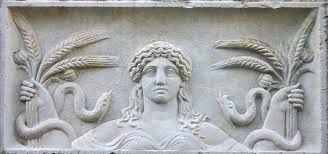 | ||
Masks for The Five Wisdom Dakinis (2016)The Dakinis are the most important elements of the enlightened feminine in Tibetan Buddhism. They are the luminous, subtle, spiritual energy, the key, the gatekeeper, the guardian of the unconditioned state. When you want to accomplish something, you always invoke the presence of the Dakinis.” — Lama Tsultrim Allione I made this Collection of Masks for a sacred dancer back in 2014, and they came to mind today, so I felt like sharing this post again. Mekare*** is a the Tantric dancer and teacher who has worked extensively with Prema Dasara and her beautiful 21 Praises of Tara dance ritual. This collection I made for Mekare represent the Fierce Aspects of the Dakinis, which she felt it was important for women to call upon in our world. Here is something she wrote about the Dakinis: "The Dakini is a primordial female wisdom energy found particularly in Tibetan Buddhism. They are called "Skydancers" for they are completely free, able to travel between worlds and dimensions, free of the entanglements of the mind, and intimate with impermanence. They dance in limitless luminous space. Embodiments of the Dakini are said to do their practices in graveyards, adorned with skulls and bone ornaments representing their intimacy with impermanence and their freedom from all fear. They are ferocious and wise, primal and magical. Fierce allies and agents of change. Their compassion is immense. They can be tricksters of the most sublime order, terrifying and demanding of truth, and also the most kind of guides, playful and nurturing. They break through barriers, invoke strength and power, guide us across the thresholds of awareness and change. Depictions of the Dakini show her with a crown of skulls, in a wreath of flame, teeth bared in ferocious display like a tiger - eyes piercing and somewhat terrifying but with a rare beauty. The beauty of understainding, compassion, and hilarity shines forth. In Tibetan Buddhist Tantra there are 5 Wisdom Dakinis, each having a specific gift of mind transformation - the transformation or transmutation of the poisons of the mind into wisdom."...............Mekare I immediately related to the Dakinis being associated with the Five Elemental forces. My sense is that they are like the Devas, primal beings, builders and creators. Their concerns and origin are not necessarily human. In this sense, they are elemental beings, associated with the 5 Directions. Air, Fire, Water, Earth and Center or Aether. Perhaps, like Kali dancing with Her skull necklace, the skulls and bones that adorn them represent a ferocious hilarity at the fears that beset us, and the reality of impermanence. Mekare went on to say: "Dakini is a source of refuge. Besides taking refuge in the Three Jewels (Buddha, Dharma and Sangha), we also take refuge in the Three Roots (Guru, Yidam and Dakini): Guru as the root of blessings because he or she will guide us to attain enlightenment; Yidam as the root of accomplishment because through the skilful method of practicing on an Yidam or tutelary deity, one will realise the nature of his or her own mind; Dakini as the root of all enlightened activities since Dakini represents primordial wisdom. Dakini is associated with spaciousness, therefore has the ability to give birth to limitless prospects of enlightened activities: pacifying, enriching, magnetising and destroying. Dakini also embodies the union of emptiness and wisdom. There is nothing more than this. A Dakini has the ability to move freely in space which is beyond thoughts and beyond fabrications. This is the state of awareness which is under control, stable and yet free. Everyone has the ability and the potentials to realise the Wisdom Dakini principles or nature within oneself." The Green Karma Dakini, Element of Air The transmutation of overwork, struggle, and competition into all-accomplishing wisdom and enlightened activity. Associated with Karma Dakini: Fulfillment. Aware choice. Grace. Ease. The Tao. The Martial Artist aware in every direction. Compassionate and capable action in the world. The Red Padma Dakini, Element of Fire The transmutation of desire, lust, and grasping into discerning awareness. Associated with Padma Dakini: Compassion. Radiance. Magnetism in order to bring benefit. Warmth. Comfort. Delight. Joy. The Gold Ratna Dakini, Element of Earth The transmutation of arrogance and greed into equanimity and generosity. Associated with Ratna Dakini: Abundance. Stability. The richness inherent in every moment and everything. Golden. Generosity. Enrichment. The Blue Vajra Dakini, Element of Water The transmutation of confusion and anger into mirror-like wisdom. Associated with Vajra Dakini: Clarity. Precision. Intelligence. Intuition. Reflection. Clear seeing wisdom. The White Buddha Dakini, Element of Space The transmutation of despair, depression, apathy, and disconnect into illuminated spacious mind. Associated with Buddha Dakini: Calm. Peace. Spacious. Soothing. Realization of connection and the web of all. The restful state of enlightened mind.
*** MEKARE is a Sacred Dancer, Artist, Storyteller, Shamanic Bodywork Therapist, and Visionary Creatrix who is passionate about embodiment, evolution, sacred dance, and healing. She has traveled extensively, studying with indigenous healers and dancing ecstatically around the world, including performing for His Holiness the Dalai Lama in the Mandala Dance of the 21 Praises of Tara with Prema Dasara. |


























